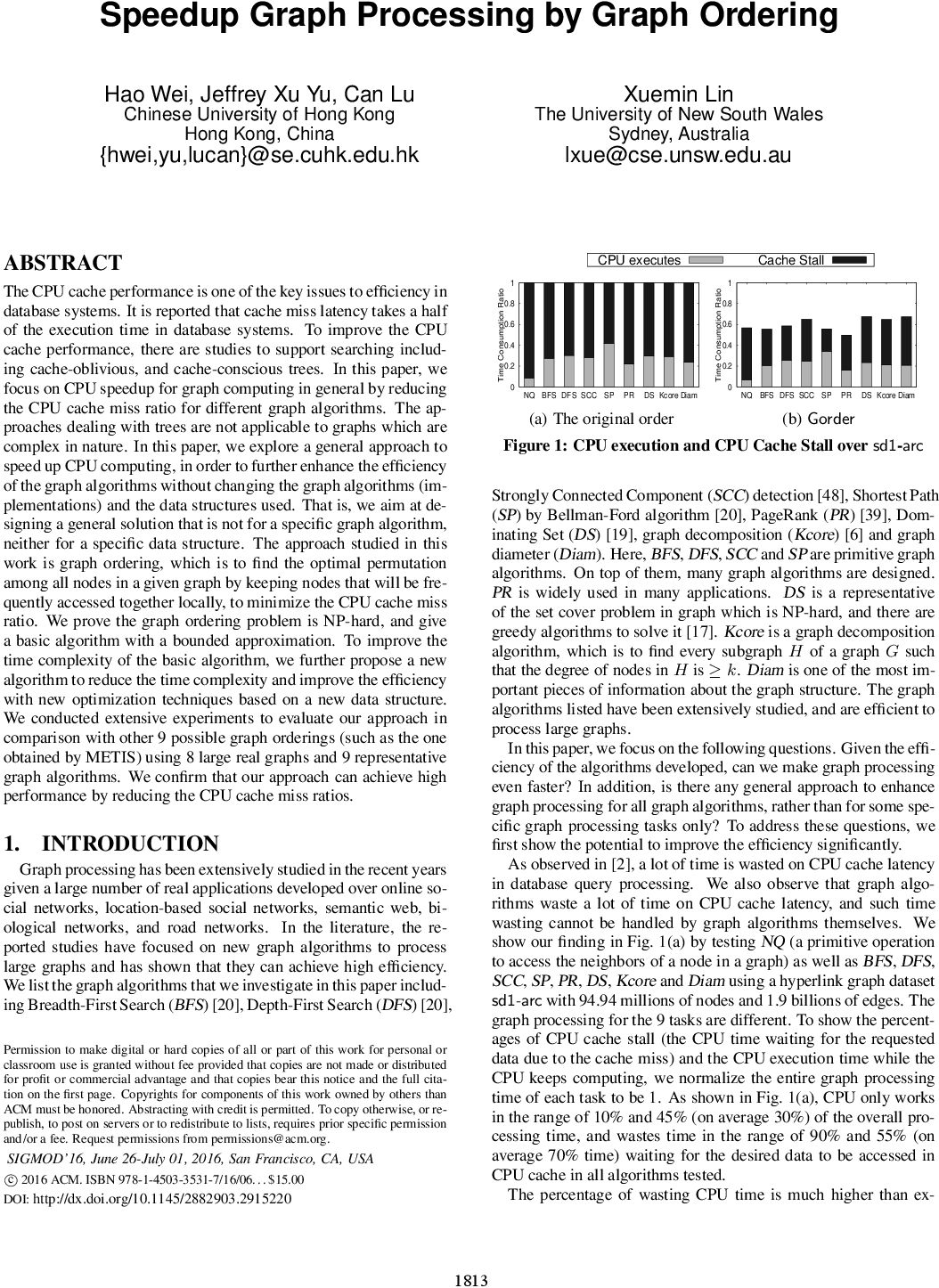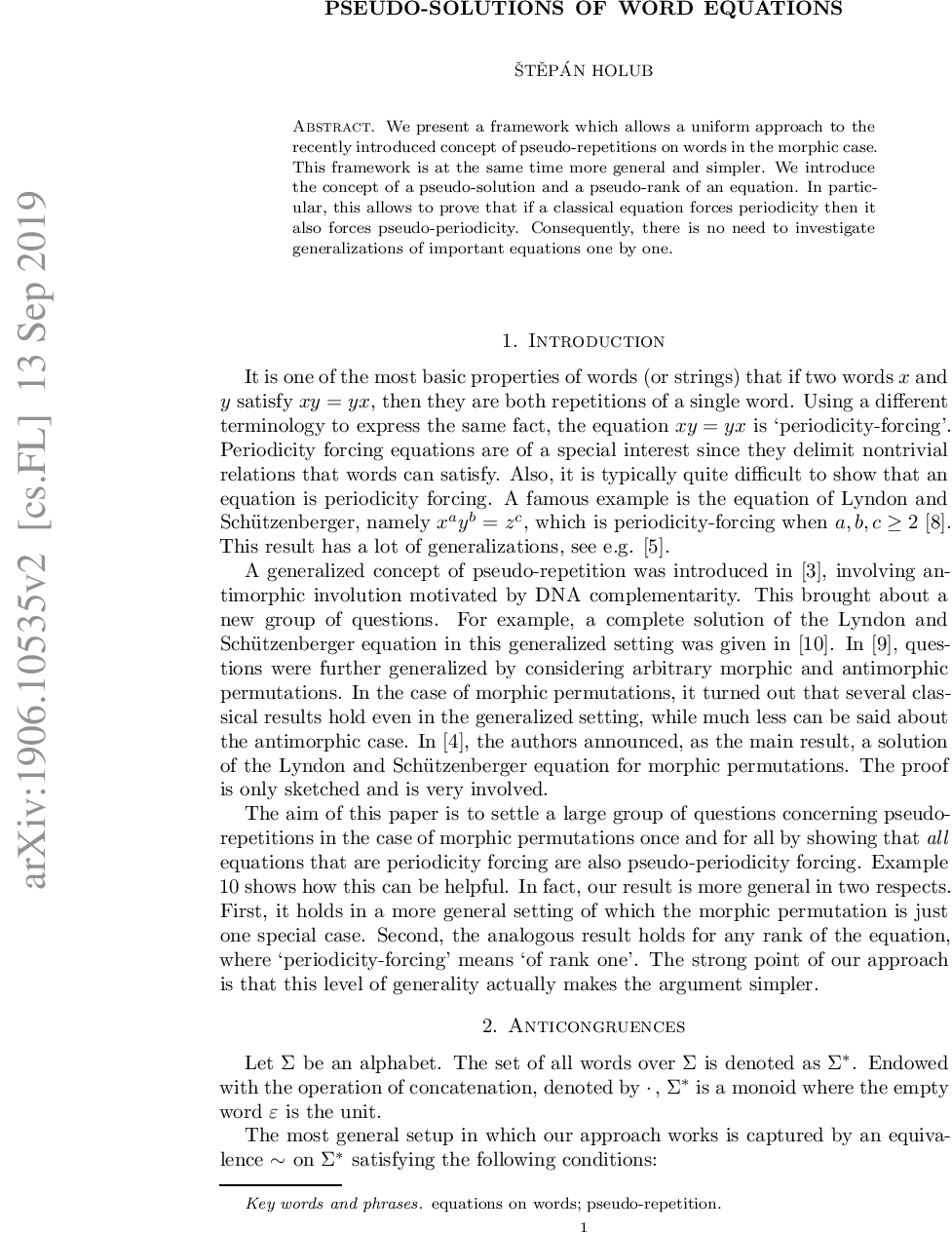

☆
1
Comments:
Great paper! A pleasure to read!
- Using the proposed ordering divides the running time by no more than two compared to using other orderings. This is a bit disappointing.
- Why no comparison against a random permutation of the nodes? I'm curious how bad a random ordering performs.
- "the optimal score $F_w$ cannot be computed due to the NP-hard complexity": such as it is, this statement is not true since only a few real-world datasets are considered. In practice, these real-world datasets could lead to easy instances of the problem.
- Is there any publicly available implementation of the proposed algorithm?
I find the following paragraph confusing:
"In general, the problem of finding the optimal graph ordering by maximizing $F(\phi)$ is the problem of solving maxTSP-$w$ with a window size $w$ as a variant of the maxTSP problem. To solve the graph ordering problem as maxTSP-$w$, we can construct an edge-weighted complete undirected graph $G_w$ from $G$. Here, $V(G_w) =V(G)$, and there is an edge $(v_i, v_j)\in E(G_w)$ for any pair of nodes in $V(G_w)$. The edge-weight for an edge (vi, vj) in $G_w$, denoted as $s_{ij}$, is $S(v_i, v_j)$ computed for the two nodes in the original graph $G$. Then the optimal maxTSP-$w$ over $G$ is the solution of maxTSP over $G$. Note that maxTSP only cares the weight between two adjacent nodes, whereas maxTSP-$w$ cares the sum of weights within a window of size $w$."
I think that:
- The index $w$ of $G_w$ does not refer to the window size $w$, but stands for "weight".
- It should be "the optimal $F(\Phi)$ over $G$ is the solution of maxTSP-$w$ over $G_w$" instead of "the optimal maxTSP-$w$ over $G$ is the solution of maxTSP over $G$".
- On the same line, in the paragraph above that one: "The optimal graph ordering, for the window size $w= 1$, by maximizing $F(\Phi)$ is equivalent to the maximum traveling sales-man problem, denoted as maxTSP for short.". It should be clear that maxTSP should be solve on $G_w$, where $w$ stands for weight: complete graph with weight $S(u,v)$ on the edge $u,v$.
MINORS:
- "The night graph algorithms" and "the night orderings": "night" instead of "nine".
Interesting comments.
> - Using the proposed ordering divides the running time by no more than two compared to using other orderings. This is a bit disappointing.
Yes, but from Figure 1, we can draw that we cannot expect much more than this... Maybe 3 or 4 at most.
> - "the optimal score $F_w$ cannot be computed due to the NP-hard complexity": such as it is, this statement is not true since only a few real-world datasets are considered. In practice, these real-world datasets could lead to easy instances of the problem.
Very relevant, still it looks very much like looking for the best solution of a TSPw on a real instance. I understand that they actually found the optimal $ F_w $ in some cases (Table 1).
Every time I see how people optimize CPU or disk cache usage, I admire it.
It makes me think that optimizing the [speculative execution](https://en.wikipedia.org/wiki/Speculative_execution) and branch prediction could also be used to this end.
☆
1
Comments:
A famous example of the periodicity forcing word equation is $xy =
yx$. It means that if a word $xy$ equals to a word $yx$, obtained by
a _cut-and-swap_ process, there exists a word $w$ and integers
$i,j$ such that $x = w^i$ and $y = w^j$. The paper's Section 1 and 5 contain a
brief yet very helpful overview of existing results about periodicity
forcing.
About ten years ago, Czeizler, Kari and Seki, in their work [On a
special class of primitive words](https://www.csd.uwo.ca/~lkari/mfcs.pdf), have introduced a notion of a
pseudo-repetition. It can be explained with the following example.
When DNA molecules are regarded as words, the Watson-Crick
correspondence $$G \sim C, A \sim T$$ between guanine ($G$) and
cytosine ($C$), adenine ($A$) and thymine ($T$) allows us to say that
a word $ATCGATTGAGCTCTAGCG$ contains the same information as the word
$TAGCTAACTCGAGATCGC$. A pseudo-repetition is a repetition of a word
or its Watson-Crick complement. So, for instance $ATC \sim TAG$, and
the word $ATCTAGATCATCTAG$ is a pseudo-repetition of the word $ATC$.
In an abstract algebraic setting (involving monoids, morphic
permutations, equivalence classes and anticongruences), the author
studies an extension to the notion of periodicity forcing, using the
recently introduced concept of pseudo-repetitions and related
ideas. Holub proves, for instance, that any periodicity forcing
classical word equation also forces a pseudo-periodicity. He provides
interesting new results and generalizations of already known results.
MathSciNet:MR4074724.
☆
1
Comments:
Nice coarse-gaining based heuristic to partition the nodes into k sets of similar sizes minimizing the number of edges between those sets.
Random maximal matchings are used to coarse-grain the graph. Maybe fast heuristics to obtain a large maximal matching can be considered, such as using the two rules detailed here: [Karp-Sipser based kernels for bipartite graph matching](https://papers-gamma.link/paper/160).
Publicly available implementation: http://glaros.dtc.umn.edu/gkhome/metis/metis/overview





Comments: